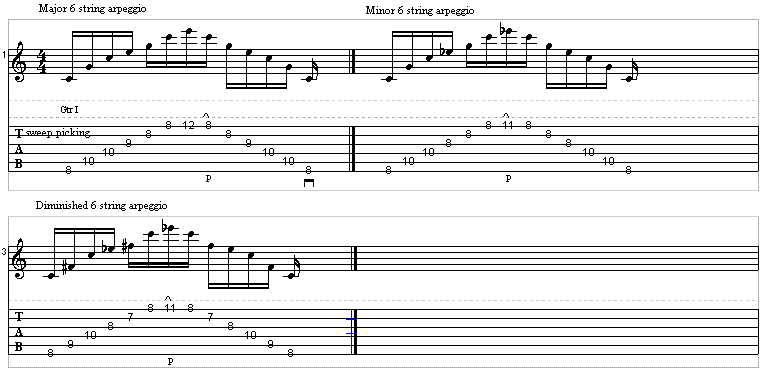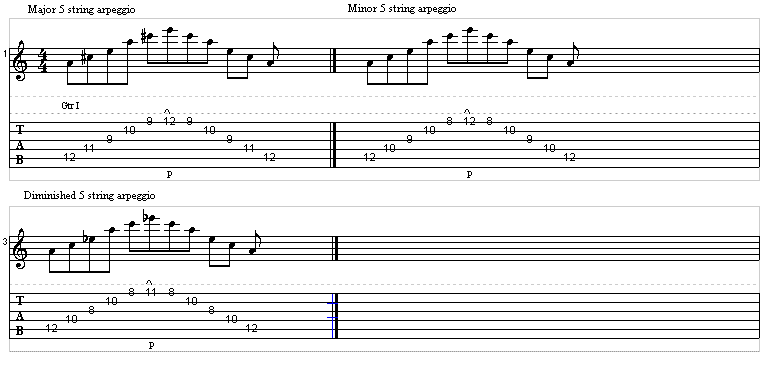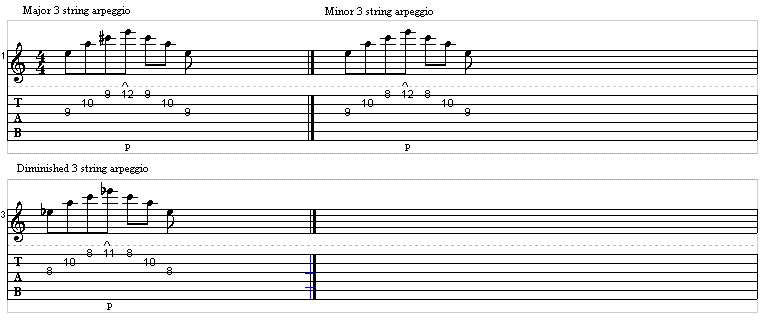One of the most requested techniques that most budding shred monsters most yearn to learn are arpeggios. Be they applied with the judicious use of sweep picking, string skipping or tapping, most rockers want them in their arsenal. Not surprising since no other bit of guitar rippery can make a newbie soil themselves so completely as sweeps played fast and furious across the fretboard. But one thing I have noticed recently is that while many would be Yngwie's can play arpeggios very fast all over the fretboard, they often have no clue as to what arpeggios go where. It may impress your buddies at Guitar Center that you can weedle up and down the neck, but when you get ready to step in the ring with the big boys, you'd better know what you're doing. The field of sweep arpeggios is what we will focus on in this article. Sorry, but string skipping and tapped arps will have to wait for another time. Even in the field of just sweeps there are way too many variations to cover here, so we will look at the basics.
You will no doubt look at the shapes once you have played them and realize that they look astonishingly similar to regular ole' barre chords. That is because, for the uninitiated, an arpeggio is defined as the notes of a chord played individually. Hence these shapes are based off of the very same barre chords that you already know, and no doubt love. For the major and minor shapes, try to use a rolling finger motion to get from point A to point B. Muting is critical so make sure to lift your finger as you roll through the shape. Also, follow through with your pick hand palm to stop any noise in its tracks. All pick motion should of course be in one direction letting the pick fall from string to string when ascending the arpeggio, and dragging on the descending part. Keep it even, keep it safe.

You will be picking these with the same instructions as the six string shapes. These shapes however, will all start with your pinky finger and flow in a more linear fashion than the last shapes. Yes, you have to learn the diminished shape. And yes, I do think less of you for asking.

You will want to notice that this shape is actually an inversion, meaning that the note you are starting on is the fifth of the arpeggio (a second inversion if you really want to know). Other than that, the execution is still the same rules as the other shapes. If you are new to sweep picking, I would ask that you start here lest you lose heart and wind up an Emo dude (a fate worst than being Britney's publicist).

In order to develop speed you will want to spend some quality time with your metronome. As usual, you will want to start slow and build up your chops gradually. However, this time set the metronome to a moderate tempo and try increasing your speed by increasing the division to the beat. Start with eighth notes (two notes per beat), then triplets (three notes per beat), then sixteenth notes (four notes per beat), and then sixteenth note triplets (six per beat). Once you hit sixteenth note triplets you should then begin increasing the tempo. Don't even think about going any faster than you can play cleanly. Remember in order to play fast you have to play slow. I know it makes no sense on the face of it, but neither does Bill O'Reilly and he has millions of viewers, and I am now realizing that I forgot what my point was, but I bet I was sure going some where with that one.
In my mind there are two main approaches to applying arpeggios. In one scenario you will play the arpeggio that fits the chord you are playing it over. So an A minor chord gets an A minor arpeggio, a C# diminished gets a C# diminished arpeggio and so on. This is really good at achieving a very composed, if predictable, sound.
The second option is to use Diatonic arpeggios. This means that you will play the arpeggios that belong to a given key. The easiest way to find your diatonic arpeggios is to follow a major scale while building the following pattern: First scale step (major), second scale step (minor), third scale step (minor), fourth scale step (major), fifth scale step (major), sixth scale step (minor), seventh scale step (diminished). These arpeggios will all work over chord progressions in the key in which you have chosen to build the scale. Be careful though, just because a note belongs to a given key doesn't mean that it will be a good note to end a phrase on. The only thing uglier than resolving on a tritone, is watching Tom Delay hosting Showtime at the Apollo. So stick to chord tones, or just trust your ear. If you land on a note that sounds like Bjork shrieking after stubbing her toe in the Icelandic winter while on a five day meth bender, keep going until it sounds like Sade. Remember, you are never dead until you stop playing.
Get started on these simple triad arpeggios to get your feet wet with sweeps and playing arpeggios diatonically. I will continue to develop these arpeggios and add several octaves, string skipping, tapping, and seventh chord arpeggios in future articles. First thing is first though, get these guys down and you will be on the path to sweep paradise. Be good, practice hard.
Scott Allen is a 1996 graduate of the Musician's Institute, G.I.T. He currently teaches guitar to 65 to 70 students weekly at Northridge Music Center.
His latest CD is entitled "III", featuring his impressively fluid playing, with a style marked by an incendiary sense of phrasing.